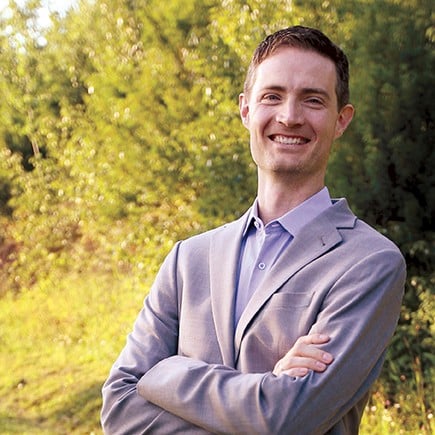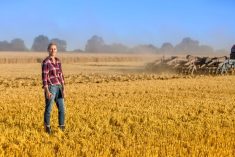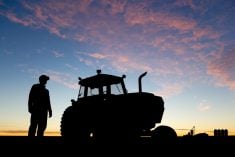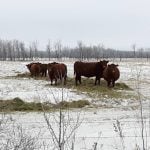What happens if you squeeze a few extra drops out of an orange while making juice? One small extra sip, of course. But what if you squeezed out a few extra drops from 1,000 oranges? You’d get a lot more orange juice at no extra cost. Could the same be true of food production? Why not? After all, it boils down to the same simple principle: marginal gains theory.
The brainchild of British cycling coach Sir David Brailsford, marginal gains theory is the concept of tiny changes that add up over time.
The theory’s three principles are:
Read Also

The big squeeze: How to be fair to siblings during farm succession
Managing sibling business relationships on family farms.
- The change must be small, but the outcome must be large.
- The change should be “easy” or “simple” to apply.
- The change should be relatively “inexpensive” to deliver.
Brailsford was determined to change the fate of his country’s cycling program, so prior to the 2004 Athens Olympics, he became the cycling team’s performance director. His focus on small, yet critical, aspects of performance, such as power output, nutrition and physical fitness, won the team 59 victories in various disciplines.
What does this have to do with agriculture? Well, everything. The principle is malleable enough that it can be applied to riding a bike just as easily as to weaning weights or seeding wheat.
Brailsford said, “The whole principle came from the idea that if you broke down everything you could think of that goes into riding a bike, and then improved it by one per cent, you will get a significant increase when you put them all together. There’s fitness and conditioning, of course, but there are other things that might seem on the periphery, like sleeping in the right position, having the same pillow when you are away and training in different places.
“Do you really know how to clean your hands? Without leaving the bits between your fingers? If you do things like that properly, you will get ill a little bit less. They’re tiny things but if you clump them together it makes a big difference.”
How different would your farm or ranch be if you added one per cent more gradable meat to your cows or increased daily gains by one per cent? What if you increased overall farm yield by one per cent or improved your harvest efficiency by one per cent?
An example from James Byrne, an Ontario government beef cattle specialist, illustrates the theory with average daily gain at a feedlot.
If a producer buys a calf at 650 pounds and sells it at 1,520, then they need a gain of 2.2 pounds for 150 days and three pounds for the next 180 days. If those numbers improved by one per cent, the animal comes out weighing 1,528.7 pounds. Sounds negligible, right? Well, that’s 8.7 pounds, and if you have 1,000 cows, that’s 8,700 pounds of extra meat. Just adding 0.003 pounds to the animal per day, you will earn an extra $21,000 gross revenue. (April 2024 Ontario market prices)
That’s a simple change relatively easy to institute, and simple is one of the theory’s guiding principles. If a change isn’t easy to implement, the cost will be irrelevant, explains Byrne.
“Say you add a yeast product into their diet to reduce instances of acidosis. The question becomes, ‘how do I incorporate this into a TMR?’ If the practical application of it is challenging, then the producer is not going to adopt it, even if you ignore the cost of it, because it’s too onerous,” he says.

He points to the example of properly measuring your pasture. It’s a highly beneficial practice, but it’s time-consuming and involves lots of work, running around and data entry. No sweat for a post-grad, but not practical for a producer.
Ideally, for the theory to be at its functioning best, it must hit the trifecta. Success is possible with one or two boxes ticked, but when all three coincide, a producer starts to win big.
“In order for marginal gains to be really successful and for somebody to see the real benefit of it and to be persistent with it, then the change has to be both small, easy and relatively inexpensive,” Byrne says.
Byrne notes that what often holds people back is getting stuck in their own minds at the starting line. They may have an idea of their end game, but how to get there is such a dizzying prospect that they do nothing, fearing the adjustment will be too difficult.
“For a producer who has never done it before, there’s a leap of faith involved and that’s where there’s another blockage in the system. Do you really believe it’s going to be successful? What is the change that I want to make?”
Small tweaks, big benefits
When Ryan Galbraith thinks about small changes at his Minnedosa, Man. farm, one of them doesn’t involve getting his hands dirty. The small gains he’s worked on are between the ears.
“Every bit of opportunity over the last few years has come to us and I think it’s just a switch in trying to figure out how to position yourself,” says Galbraith.
He is constantly thinking about ways to be more efficient at the family farm, which includes his brother and parents. Part of what drives that is his farm’s location. At the base of Riding Mountain National Park, Galbraith operates at an elevation between 1,600 and 2,000 feet above sea level. It means his growing season is shorter than the average Prairie farmer. He is part of a peer group and while farmers based in Saskatchewan were sharing photos of a half-done harvest, Galbraith had yet to turn a wheel as of late August. It means all his decisions are more time-sensitive and must be meticulously thought out.
“I’ve taken professional courses and I’ve tried to always continually better myself and not worry so much about competition per se from my neighbours. I don’t care to worry about what they’re doing; we just keep doing what we’re doing. For a long time, we really wanted to grow and nothing was coming our way and then all of a sudden these opportunities start coming and it feels like the work has paid off,” he says.
A small, incremental, yet always difficult, challenge for the young farmer has been delegation. When Galbraith, 33, returned to the farm 14 years ago, it was just him and his father. The two of them worked day in and day out, doing all the jobs themselves. Today, Galbraith is much better about delegating and has employees, another small change with big rewards.
He’s often asked himself if there’s a benefit to having someone else do the work or if he should just continue to do it himself because he knows best. Purposeful time in thought has paid off, even if it’s not always a smooth process.
“In the early years, you feel like you can still do things better than the next person, but I’ve come to understand what freeing your time up as the manager can do for the operation. I spend a lot of time on bigger-picture thinking.
“Sometimes you don’t have the properly qualified people and so you’re training them while you’re trying to delegate these tasks to them. You’re trying to guide them and there’s this awkward stage of offloading the responsibility while still being accountable for it. Delegating just allows you to do what’s better for the business. If you delegate and the business is doing good and then you want to take a free afternoon or a day here or there to spend time with the family, that’s a pretty nice bonus.”
Some of the marginal changes, however, are more easily quantifiable. For several years, the family had a granular fertilizer and seed tender truck as well as a liquid fertilizer tender truck. They made it work, but it meant their employee was run off his feet 12 to 16 hours a day managing both.
“We made it one unit and sped up a few things in the yard with a different size auger for the fertilizer,” he says. “All of a sudden, the guy had a spare hour or two every fill to do truck maintenance or work around the yard before he had to come back to the field. He could keep the yard a little tidier, too. It just opened our eyes to how making a few small changes in the loading site drastically changed our logistic efficiency.”
Another minor change with a big gain was with their sprayer setup. They had a single small chemical handler and would splice every jug as they were filling the sprayer. The process itself usually took about 15 minutes per fill. That was a lot of down time, though. Galbraith decided a change was needed. So, he built his own dash trailer on a flat deck trailer. Today, they have four chemical handlers on the flat deck with chemical pre-loaded. The sprayer pulls up beside the trailer and chemical is pumped immediately.
“It went down from about 15-minute fills to five,” says Galbraith, adding that spray days were few and far between this wet spring, and their new system made all the difference. “In our country we’re not square quarters, there’s lots of sloughs and potholes and hills. We figure we gained one to two loads per day on a 12-hour spray day. You save money there and you gain the efficiency of the actual setup.”
The changeover cost about $80,000, no small invoice, but it was nearly a 100 per cent savings compared to buying a brand-new version of what Galbraith made himself.
“I had some family members that were pretty skeptical because the price point wasn’t cheap to make the change, but they came back to me mid-spring season and said, ‘wow, we’re way quicker and we’re really saving money there.’ When the team’s buying in and understanding what we’re trying to accomplish, it just kind of reassures you that you did the right thing.”
Another change he believes will pay off is creating a new bin site with about 280,000 bushels of storage. Given the recent rail strike scare, Galbraith says it’s already proving to be an even better decision, despite not having a single bushel augered in yet. While he will still use some amount of grain bags, he thinks their harvest efficiency will surpass last year’s.
“I’m hoping that’s what I’ve calculated out. There should be a time savings there for us. I got it all figured out. Let’s see if it comes to fruition,” he says with a laugh.
Little by little with cattle
When it comes to cows, every little bit helps. Just ask Kyle Hebert, owner of Hebert Livestock Ventures near Wawota, Sask. Hebert and wife Crystal have zeroed in on a few key changes in recent years and the time and money they have in their back pocket attest to the changes’ positive benefits. The single-most important change they’ve made over the years is moving their calving dates from February to May for their 950 cows.
Anyone who has calved in February understands the absolute challenge of it all: mother and calf in their most vulnerable states, freezing temperatures, at times a lack of help, shortage of space and more.

Hebert and crew first moved the dates from February to April 10 years ago. However, April in his area can still be a treacherous month with a couple of nasty storms almost a guarantee.
“We have snowstorms and that can usually kill baby calves,” he says. “That’s hard on us because we love what we do. I said I would never do that again.”
One more small, yet important, change was to come.
After the brutal calving season of 2020, they shifted the dates from April to May 2021. It was a significant change on top of their previously significant change moving to April calving. But the benefits were twofold. The May weather meant less stress on everyone, especially the animals. It also meant that the person-to-cow ratio was now 1:500 instead of 1:300 which it was in April. February, a distant calving memory, was a mere 1:150 cows.
“It’s made it so you can enjoy it,” Hebert says of May calving. “Most of us have cattle because we love calving cows. I always say that we get to play God for 60 days and to get 1,000 babies born in 50, 60 days, it’s a pretty fun time of year.”
Overall, this change reduced newborn mortality by two per cent. Amortized across so many animals, Hebert would never conceive of calving at any other time: “On 1,000 calves that starts to pay for people’s wages.”
During the winter, the Heberts swath graze millet for the cows. The first person in his area to embrace the practice, Hebert builds a temporary fence, which takes about 90 minutes to construct, and moves his mother cows every four to five days.
The time it takes to build the fence is about the same amount of time it takes every day to feed the animals with a mixer wagon if they were all in the main yard. The time savings over the course of a winter is about 170 hours. At the same time, Hebert has saved the costs and time involved to put the feed up and bring it home before taking it back out to the cows. That time has been converted into many things, including more time spent at the rink.
“There is the cost of missing minor hockey games. In the last five years, that’s become something that I had to make more important. Our kids want Dad to be there a little more and it turns out that this saved us about a dollar per cow per day, for 60 days on those 600 cows. That helps a lot.”
And sometimes a good opportunity presents itself and it seems too good to pass on.
In 2021, the government’s farm and ranch water infrastructure program came available, and Hebert took advantage to trench two miles of pipe for remote winter watering. The cost was $25,000, but the government footed half the bill. The benefits to this marginal gain include keeping the cattle in the natural protection of the trees instead of in the open yard, which has made them healthier and less stressed. He prefers them to be away from the yard because it cuts out having to pay an employee to clean up after the animals.
“It’s helped a lot with animal health and we’ve gained pounds on our calves just because they’re drinking clean water all the time,” he says. “Usually in the wintertime they’re walking out on a dugout where we’ve cut them a hole, so if they’re drinking free-flowing water, it’s a lot less stressful and a lot less dangerous to them. We truly believe that we’ve got our money back out of that 100 per cent.”
Hebert says the pregnancy rates have improved as well, which he partially attributes to healthier animals accessing clean water 24/7.
Currently, he sits as a director for Zone 1 of the Saskatchewan Cattlemen’s Association. The conversations and people he meets through the organization have helped him try new things and to not be afraid to fail and even to be adventurous with his work.
“When it’s just a little thing, if it’s wrong, it’s not going to cost you a bunch, but sometimes it costs a lot more not to try it,” he says. “I think that’s what’s wrong with our agriculture industry. We tend to not want to try new things or make changes and we get stuck in ruts where we don’t ever see the positives to change.”
















